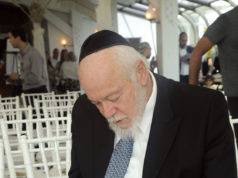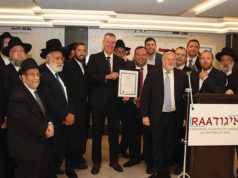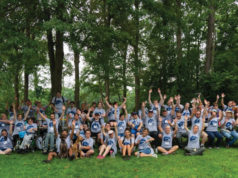 The Peruvian Jewish community is small. Out of a general population of about 27,000,000, there are fewer than 3,000 Jews. Almost all of them reside in the capital city of Lima. There are traces of remains of other Jewish communities in other cities, but most of these consist of intermarried descendants and are not counted in the official community calculation. Stories also surface occasionally of Converso communities in remote jungle areas but, once again, as these rumors remain unsubstantiated, members of such groups are not considered part of the contemporary community.
The Peruvian Jewish community is small. Out of a general population of about 27,000,000, there are fewer than 3,000 Jews. Almost all of them reside in the capital city of Lima. There are traces of remains of other Jewish communities in other cities, but most of these consist of intermarried descendants and are not counted in the official community calculation. Stories also surface occasionally of Converso communities in remote jungle areas but, once again, as these rumors remain unsubstantiated, members of such groups are not considered part of the contemporary community.
Many Conversos arrived during the 16th and 17th centuries, however the roots of the modern community dates back to the mid-19th century with the arrival of Ashkenazi Jews from Western and Central Europe, including England, German lands and Alsace who settled in Lima. Later in that century, Jews from North Africa arrived. They were mainly attracted by the development of a rubber industry, settling in the lands around the Amazon and in the town of Iquitos.
In the pre World War I and inter-war periods, more Jews arrived from Europe (this time, largely from Eastern Europe) and from the lands of the disintegrating Ottoman Empire. In the 1930s, a substantial group of German Jews arrived, the second group of immigrants from that region. Recently, as the economy has stabilized, some additional Jews have been attracted from Argentina and other lands.
At its largest, the population reached around 6,000, but has declined due to a mixture of political and economic problems.
The composition of the population has changed in the last generation. Thirty years ago, most of the Jews in the community were involved in business and trade. Today many are in salaried jobs in industry or professional positions and in recent years, more Jews have entered the world of politics: there was even a Jewish prime minister. The community can generally be called middle-class; but it should be noted that, as in most countries in Latin America, this class is increasingly vulnerable and has tended to suffer from recent economic and financial instability.
The Jewish community is an amalgamation of three different sub-groups, each of whom are defined as communities. The strongest and most established, accounting for approximately 75% of the community, is an Eastern European Ashkenazi stream. In addition, there is a more modern Ashkenazi-German stream, which accounts for about 15% of the community. The third, Sephardi-Mizrachi stream accounts for the remaining 10%. These three streams cooperate in the running of the community, rotating the leadership between them.
There are currently three synagogues in the community. Two follow the Orthodox tradition (one Sephardi and one Ashkenazi), while the third is defined as Conservative. Perhaps the institution that most defines and unites the community is the community school, named after Leon Pinelo, which gives a full education to 90% of the Jewish children in the community. It only accepts children from families that are officially defined as Jewish. The school is much smaller than it used to be, enrollment has fallen from over 1,000 at the beginning of the 1970s to around 400. The story of Leon Pinelo school began in 1945 when Nathan Bistritzky, an educator trained in Europe, arrived in Peru with the desire to create a Jewish school to guide the youth of the country and allow them to grow within their traditions. He wanted to incorporate history, language, festivals and traditional customs of the Jewish people in the lives of these families.

Despite its small numbers, the community appears to have a lively cultural and social life. There is a sports and country club, the Hebraica. Many of the current community leaders have come out of the ranks of the one flourishing youth movement, HaNoar HaTzion, established more than 50 years ago. The community also supports two old age homes for its members. There are a number of Jewish organizations in Lima, many of which have connections with Israel. One of the stronger bodies is Bnei Brith. Since the early to mid-20th century, the Jews of Peru have tended to lead a fairly insular life within their own community and around their own institutions.
One of the factors that has led to cohesiveness within the Jewish community is the fact that Peru is a strongly Catholic country. The reason that has mainly influenced the inflow of Jews to Peru seems to have been the possibility of improving their economic status. On the other hand, four elements have caused Jews to leave. Some Jews left when the economic situation in Peru worsened. This was the case with many of the early Ashkenazi immigrants, who left in the last years of the 19th century. A similar situation developed in the early 1970s, when a radical government started a program of nationalization that frightened many Jewish traders and business people. The last decades of the 20th century were generally marked by tremendous economic instability and very high inflation, which also effected Jewish emigration.
A second set of factors that developed in the late 20th century was connected with political instability. This resulted from the actions of left wing underground and terrorist groups that declared war on the government. The 80s and early 90s were particularly uncertain and fearful—especially among the middle and upper classes. As kidnappings, robberies and car bombs became commonplace, many decided that it was time to leave. The underground groups have almost disintegrated since the early 1990s, and now pose little threat to the regime or the middle class residents of the country.
A third, more recent, reason for leaving is the desire of young Jews to look for fresh horizons and romantic prospects. The fourth reason is the community’s strong connection with Israel. Over 1,000 Jews have left Peru over the years to make aliyah. This number is very large in proportion to the size of the community.
The economic climate of Peru stabilized in the early 1990s. At that time, it seemed that the community’s main problem was simply surviving in such small numbers. There has been less economic stability in the past few years, however, and the old questions are being asked once again. Nevertheless, it still seems that survival within a small community remains the main problem.
One specific challenge lies in maintaining the financial infrastructure of a completely private, all-Jewish school like the Leon Pinelo—the community’s most central institution. The number of applicants is dropping rapidly, partly because many of the wealthier members of the community, whose support is essential in keeping the school open, are increasingly turning to American schools in Lima for their children’s education.
It is difficult to predict the long-term future of this community. Hopefully it will grow larger in the near future.



